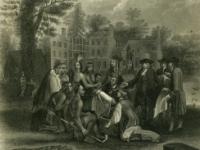This lesson is an introduction to the founding of Pennsylvania and will help the students explore how Pennsylvania was colonized in the 17th century. This is meant as an introductory lesson to immerse students into the world of William Penn and create a foundation for future lessons. Using the documents provided, students will understand how Pennsylvania received its name, learn the beliefs of the Quakers, the relationship of the colonists with the Native Americans, and the chronology of events which took place during colonization. It will also incorporate new vocabulary words for the students to utilize in their own writing.
William Penn, born in 1644, was the son of a wealthy Admiral in the Royal Navy. As a young man he joined the Quaker religion, which was illegal since any person who was not a part of the Church of England, the official religion of England, was persecuted as a religious dissenter. This caused Penn to be jailed several times and fight for the right to religious toleration. After his father’s death, Penn took over the family estate. Luckily for Penn, King Charles II owed the Penn family a fairly large debt of 16000 pounds so, rather than the King paying his debt, William Penn received land in the New World to begin his own colony. This is where the dream of a colony where Quakers could practice their religion freely became a reality with the founding of Pennsylvania. The king named the colony Pennsylvania after Penn’s father; it means “Penn’s Woods.”


